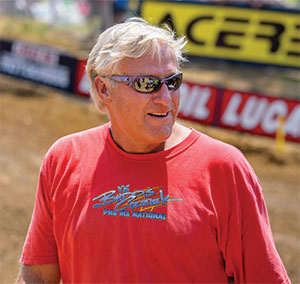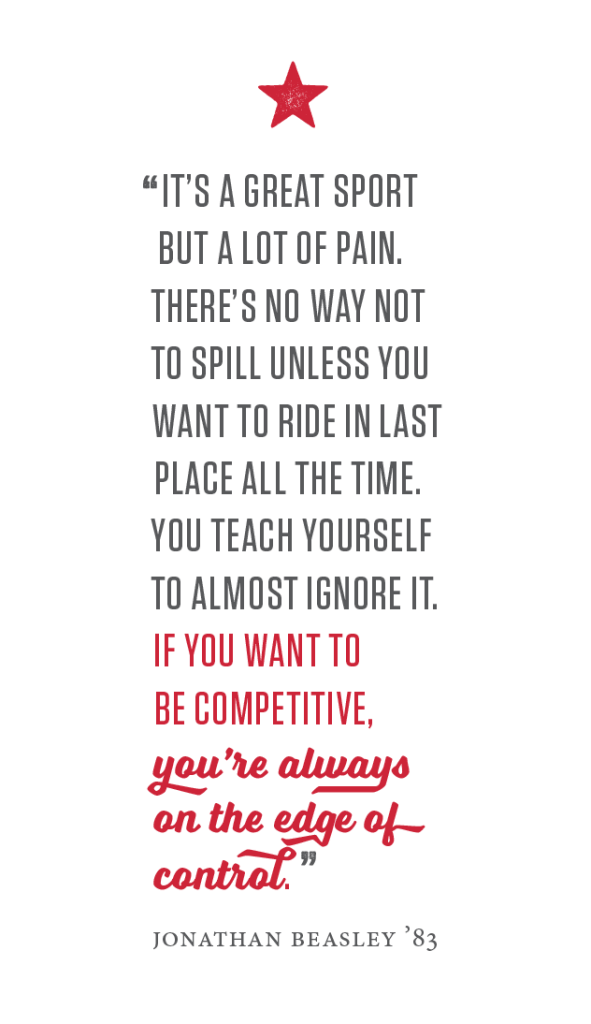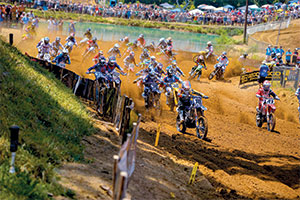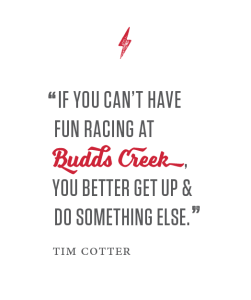- October 05, 2014
- By Liam Farrell
The impromptu city appears suddenly in the Southern Maryland countryside, as open fields turn into rows of RVs and cars with license plates from Florida, North Carolina, Kentucky, Michigan, New York and New Jersey.
The midmorning buildup of heat and humidity doesn’t deter relative latecomers to the 2014 Pro Motocross Championship series at Budds Creek Motocross Race Track. After parking on lawns along Route 234, couples, parents, children and even pregnant women drag lawn chairs, umbrellas and coolers. Nobody wears a collar and sleeves are an endangered species, with shirts next on the hit list. All are heading toward the ear-splitting siren call: roaring motorcycles producing what sounds like history’s largest swarm of hornets.

To reach the track, they must pass all the accoutrements of 21st-century action sports, a festival fairway dedicated to adrenaline rushes. There are stands stocked with Red Bull, racing shirts and souvenirs next to an enormous exhibit for GoPro cameras. Off to the side, the riders camp out before their events, napping on cots or tinkering with their bikes. Muddy little rivers crisscross the ground as one of the ubiquitous tools of motocross—the power washer—cleans the vehicles after preliminary runs.
Standing in the center of this motocross village is a rugged and long-limbed man with a shock of gray hair, who’s hawking fliers about track events later this year. At a glance, you wouldn’t know the man in a faded, red 2006 Budds Creek T-shirt and cargo shorts is the track’s owner, Jonathan Beasley ’83.
Over several decades, Beasley has turned this area outside of Mechanicsville into one of the country’s prime spots for thousands of riders and race fans, regularly hosting national championship races and even the 2007 Motocross des Nations—the “Olympics of Motocross.”
Beasley surveys the crowd ringing the valley in the brilliant sunshine.
“This is about perfect,” he says as the engines start to roar. “You can quote me on that.”
Almost Paradise
A few weeks before race day, Beasley pulls up to the track in his red, turbocharged 1988 Porsche 930. The license plate, “R1SKY,” nods at the car’s ability to top out at 210 mph, a limit he has tested.
More mundane tasks await that day, however, as he climbs the stairs of a two-story building that serves as the track’s office and concession space. Its porch, which gives VIPs a bird’s-eye view of races, needs to be stained before thunderstorms roll in. Beasley also has to pick up trophies and grab an order of fried chicken from the Chaptico Market, where he usually proposes to the 80-year-old woman who makes the pies.
Ed Day, a friend of Beasley, has been coming to the track since it opened in the 1970s. He says the Motocross de Nations—“It was massive. There were more people there than a Maryland football game”—was a symbol of Beasley’s success, the pairing of the local race community’s loyalty with the courting of a bigger and wider fan base.
“He’s nationally and internationally known as a race promoter,” Day says. “He just had the vision and foresight to stick with it.”

Budds Creek is at the comely midpoint between Maryland’s mountains in the west and the beaches in the east. If the state is truly “America in Miniature,” St. Mary’s County is probably its closest descendant of the antebellum South. Lush farms with houses labeled “Manor” lie not far from an independent gas station that sells cases of Budweiser and has a Port-O-John for its public restroom. Beasley says it’s jokingly referred to as the “Redneck Riviera,” and the locals take care to introduce themselves using all three of their given names.
Beasley was the first in his family in 200 years born outside of Tennessee. As the story goes, his father, who died when Beasley was 9, got lost while duck hunting in Calvert County. While asking for directions in Leonardtown, the nascent dentist noticed his only other prospective competition in the area was an octogenarian orthodontist.
In the 1960s, the family bought the land, once an Amish dairy farm, for hunting—about 20 deer were standing on it the first time they drove by. In the early 1970s, a local track run by naval officers was closed, and they helped the family start their own.
Beasley, who grew up in the property’s 1940s-era farmhouse, was involved from the start. Every day after school, he and his brother rode their bikes on the Budds Creek course and even at 13 years old, he would hop on a bulldozer and help maintain the track. He didn’t stop when he got to the University of Maryland, where he majored in marketing and put what he learned into practice.
Running a racetrack and going to college didn’t always mesh. Once, to leave College Park for a race, he told a professor he was needed back home because an uncle had fallen off a barn and couldn’t hang tobacco.
“I had five rows of calluses, so I could pull it off,” he says.
Beasley has lived an itinerant life, although he says, “‘degenerate’ is more the proper word.” He hitchhiked across the country for the first time at age 15, with his Boy Scout equipment, to catch a dirt bike race in San Diego. Later, the seasonal nature of the business let him be a bartender in South Beach, Key West, Aspen and Ocean City.
“I had a good time,” he says. “That’s what life is about.”
Racing was always there, though. He has a brusque assessment of his own skill as a competitive rider—“I stunk”—but was addicted to the adrenaline.
“It’s a great sport but a lot of pain. There’s no way not to spill unless you want to ride in last place all the time,” he says. “You teach yourself to almost ignore it. If you want to be competitive, you’re always on the edge of control.”
Another constant is Southern Maryland. “Jon used to own Leonardtown,” says longtime friend Ernie Pfeiff of the man’s social prowess, and it appears that he still does.

Beasley can’t go far without chatting up an acquaintance in a parking lot or waving to friends as he drives through town. A history buff, he delights in Civil War trivia, likes dropping in on the local historical society and eagerly points out the churchyard with graves of two members of the “Maryland 400,” soldiers who bravely held off the British at the Battle of Brooklyn in 1776.
Last year, Beasley helped get a local elementary school named after his childhood idol, Capt. Walter Francis Duke, what he calls “probably the best accomplishment of my life.” A Leonardtown native, Duke was an ace combat pilot in World War II who signed up with the Canadian Air Force before America entered the war and was later shot down over Burma.
“Only need a couple mountains,” he says of his hometown, “and it would be paradise.”
The Hardest Spot
Breaking into the mix of country, electronic dance music and rap pounding over the loudspeakers on race day, Tim Cotter, the event director, welcomes the more than 18,000 spectators to “these hallowed grounds.”
“If you can’t have fun racing at Budds Creek,” he says, channeling the thoughts in the muddy helmets below, “you better get up and do something else.”
Inside the track offices, the walls are covered with posters, jerseys and articles. Beasley talks about riders with none of the creeping cynicism he occasionally throws at corporate forces at work in the business.
One of his favorites was Doug Henry, who during a race at Budds Creek in 1995 launched himself far too high into the air, crashed in spectacular fashion and broke his back. A few years later, with a titanium cage around part of his spine, Henry came back and won. The hill where he wiped out is now called Henry Hill, and is where Beasley married his wife, Kimberleigh Mitchell ’89, M.S. ’99.
When asked why a rider would come back and risk another near-fatal crash—Henry actually was partially paralyzed in a 2007 wreck on a different course before returning to racing yet again—Beasley says, “They’ve spent their whole lives to get to that point.”
Injuries are the part of motocross that Beasley hates. During his senior year at Maryland, he considered walking away after witnessing one of the two fatalities to ever happen at Budds Creek, becoming so rattled he even took the Officer Candidate School exam. But he couldn’t stay away from what he calls the hardest sport in the world.
Backyard Heroes
For Beasley, race day is a tug-of-war between sports fan and track owner, as the love and admiration he has for motocross bubbles up amidst his more banal duties. Men with headsets walk back and forth on the newly stained porch, barking race updates to pit crews. Beasley stands with family and friends as the pack roars from the starting line into a brown cloud and then unwinds like a snake into contenders and pretenders.
Beasley points out one racer as the rider barrels down Henry Hill.

“I’ve never seen anyone take it that fast,” he says.
 No matter how many dips, turns and hills are thrown up along the dirt ring, there isn’t a bad vantage point at Budds Creek. In a little valley where only the elevation for tunnels is artificial, most spectators aren’t even provided stands; they simply find a place on a hill and watch the motorcycles roar by close enough to get sprayed with dirt.
No matter how many dips, turns and hills are thrown up along the dirt ring, there isn’t a bad vantage point at Budds Creek. In a little valley where only the elevation for tunnels is artificial, most spectators aren’t even provided stands; they simply find a place on a hill and watch the motorcycles roar by close enough to get sprayed with dirt.
The races, or “motos,” last for 30 minutes plus two laps. Competitors push their bikes to the limit, picking their lines in the soil, ducking into turns and flying over mounds, looking for the chance to sneak past the man in front.
Winding through the crowd, Beasley stops at trash can after trash can to tie up bags full of beer cans and discarded food, all the time preternaturally aware of who is leading the race and where the exciting battles are taking place.
So the day goes, as spectators smile and laugh and cheer at the riders shimmying for hours just to the brink of losing control and back again, dirt spurting up in their wake as they roar into the next turn.
Beasley says over the din: “It’s pretty wild seeing your heroes in your back yard.” TERP
